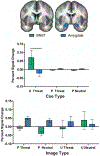Social anxiety is associated with BNST response to unpredictability
- PMID: 30953446
- PMCID: PMC6679811
- DOI: 10.1002/da.22891
Social anxiety is associated with BNST response to unpredictability
Abstract
Background: Anxiety disorders are highly prevalent and cause substantial suffering and impairment. Whereas the amygdala has well-established contributions to anxiety, evidence from rodent and nonhuman primate models suggests that the bed nucleus of the stria terminalis (BNST) may play a critical, and possibly distinct, role in human anxiety disorders. The BNST mediates hypervigilance and anticipatory anxiety in response to an unpredictable or ambiguous threat, core symptoms of social anxiety, yet little is known about the BNST's role in social anxiety.
Methods: Functional magnetic resonance imaging was used to measure neural responses during a cued anticipation task with an unpredictable, predictable threat, and predictable neutral cues followed by threat or neutral images. Social anxiety was examined using a dimensional approach (N = 44 adults).
Results: For unpredictable cues, higher social anxiety was associated with lower BNST-amygdala connectivity. For unpredictable images, higher social anxiety was associated with greater connectivity between the BNST and both the ventromedial prefrontal cortex and the posterior cingulate cortex and lower connectivity between the BNST and postcentral gyrus. Social anxiety moderated the BNST-amygdala dissociation for unpredictable images; higher social anxiety was associated with BNST > amygdala response to unpredictable threat relative to unpredictable neutral images.
Conclusions: Social anxiety was associated with alterations in BNST responses to unpredictability, particularly in the BNST's interactions with other brain regions, including the amygdala and prefrontal cortex. To our knowledge, these findings provide the first evidence for the BNST's role in social anxiety, which may be a potential new target for prevention and intervention.
Keywords: BST, amygdala, anxiety, fMRI, uncertainty.
© 2019 Wiley Periodicals, Inc.
Conflict of interest statement
None of the authors have conflicts of interest to disclose.
Figures




References
-
- Alheid GF, & Heimer L (1988). New perspectives in basal forebrain organization of special relevance for neuropsychiatric disorders: The striatopallidal, amygdaloid, and corticopetal components of substantia innominata. Neuroscience, 27(1), 1–39. - PubMed
-
- Baxter AJ, Scott KM, Vos T, & Whiteford HA (2013). Global prevalence of anxiety disorders: a systematic review and meta-regression. Psychological Medicine, 43(5), 897–910. - PubMed
Publication types
MeSH terms
Grants and funding
LinkOut - more resources
Full Text Sources
Medical

